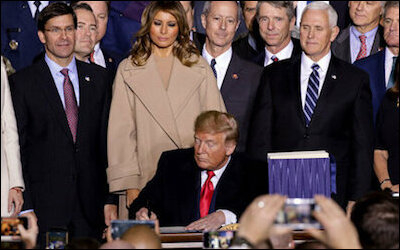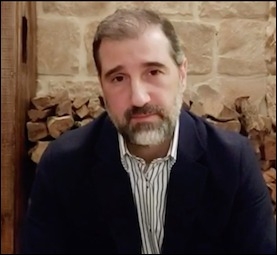by Jonathan Spyer
Quiet but unrelenting American pressure is transforming Assad's victory into ashes.

One
of many billboards in Damascus celebrating the victory of Syrian
President Bashar al-Assad. The Arabic caption reads: "If the country's
dust spoke, it would say Bashar al-Assad." (AFP)
|
What has changed, in two short years? How has Assad's triumph turned to disaster?
The answer is the Trump administration's Syria policy. The application of quiet but unrelenting pressure is transforming the Syrian president's victory into ashes. What it has yet to do is persuade Russia to cease backing the Assad regime, which means the strategy remains at a stalemate.
Quiet but unrelenting American pressure is transforming Assad's victory into ashes.
|
The main method for achieving these goals has been the strangling of the Syrian economy. Assad urgently needs money for reconstruction. The United Nations estimates the cost of Syria's rebuilding at roughly $250 billion, which is four times Syria's prewar GDP. Assad's main allies, however, have no money to give. Iran is currently reeling from U.S.-led maximum-pressure sanctions; Tehran's disastrous response the coronavirus pandemic; the cost of imperial commitments in Yemen, Afghanistan, Iraq, Syria, Lebanon, and Gaza; and the loss of the man who managed those commitments, Maj. Gen. Qassem Suleimani, who was killed in a U.S. drone strike early this year. Russia is facing collapsing oil and gas prices, as well as sanctions.
Assad urgently needs money for reconstruction, but his allies have no money to give.
|

President
Donald Trump signs the Caesar Syria Civilian Protection Act as part of
the National Defense Authorization Act (NDAA) in December 2019,
penalizing third party countries that do business with Assad's Syria.
|
Third, the United States is working to prevent a final regime military victory. Despite talk of the war "winding down," Assad and his allies still only control around 60 percent of Syria. Around 15 percent is in the hands of the Turks and their Sunni Islamist allies—recently, they started using the Turkish lira currency in those areas, in place of Syria's devastated pound. An additional 25 percent is controlled by the U.S.-aligned, Kurdish-led Syrian Democratic Forces. The United States backed Turkey in its confrontation with a regime- and Russian-led offensive in March this year. And contrary to U.S. President Donald Trump's tweet announcing withdrawal in October 2019, U.S. forces are still present in the Kurdish-dominated area.
The main U.S. goal is to secure regime acceptance of a nationwide, unlimited cease-fire.
|

Rami Makhlouf
|
For poorer Syrians, the results of all this are dire. Danny Makki, a journalist with close connections in Syrian government circles, tweeted on June 7: "The economic situation in #Syria is at breaking point, medicine is very scarce, hunger is becoming a normality, poverty is at the worst-point ever, people even selling their organs to survive."
Regime spokespeople and apologists in the coming period are likely to highlight the difficult humanitarian situation in regime areas and call for a softening of restrictions. But it's hard to credit any sincerity to the regime's belated discovery of humanitarian concerns toward its own citizens. In covering Syria from the early years of the civil war, I witnessed the deliberate targeting of civilian infrastructure, including hospitals, by the Assad regime's air force in Aleppo in the summer of 2012. Such tactics, replicated throughout the country, were the main reason for the terrible loss of civilian life during the Syrian war, and they were never informed by the regime's newfound humanitarianism.
The U.S. strategy has not yet succeeded at its ultimate aim of changing the Syrian regime's calculations. The main result instead is emergent strife between different elements of the pro-regime camp, including Russian public criticism of Assad, the falling-out between the president and Makhlouf, and growing tensions between Russian-aligned and Iranian-aligned elements of the Syrian security forces in strife-torn Daraa. But a strategy of this kind doesn't require immediate results. The direct cost to the United States of an economic blockade of Assad's Syria—like the maximum pressure campaign against Iran—is low or nonexistent.
The key obstacle facing Assad is the weaponization of Western economic strength.
|
Although Syria's active war may have largely concluded, the United States has ensured that its underlying issues remain unresolved. The resulting stalemate—marked by frozen conflict, continued poverty, and a messy de facto division of the country—has prevented a triumph for Assad and his allies. This will remain the country's only practical future until Assad and his allies are finally prepared to negotiate on terms that their opponents are willing to accept.
Jonathan Spyer is director of the Middle East Center for Reporting and Analysis and a Ginsburg/Ingerman Writing Fellow at the Middle East Forum.
Source: https://www.meforum.org/61178/trump-syria-policy-is-working
Follow Middle East and Terrorism on Twitter
No comments:
Post a Comment